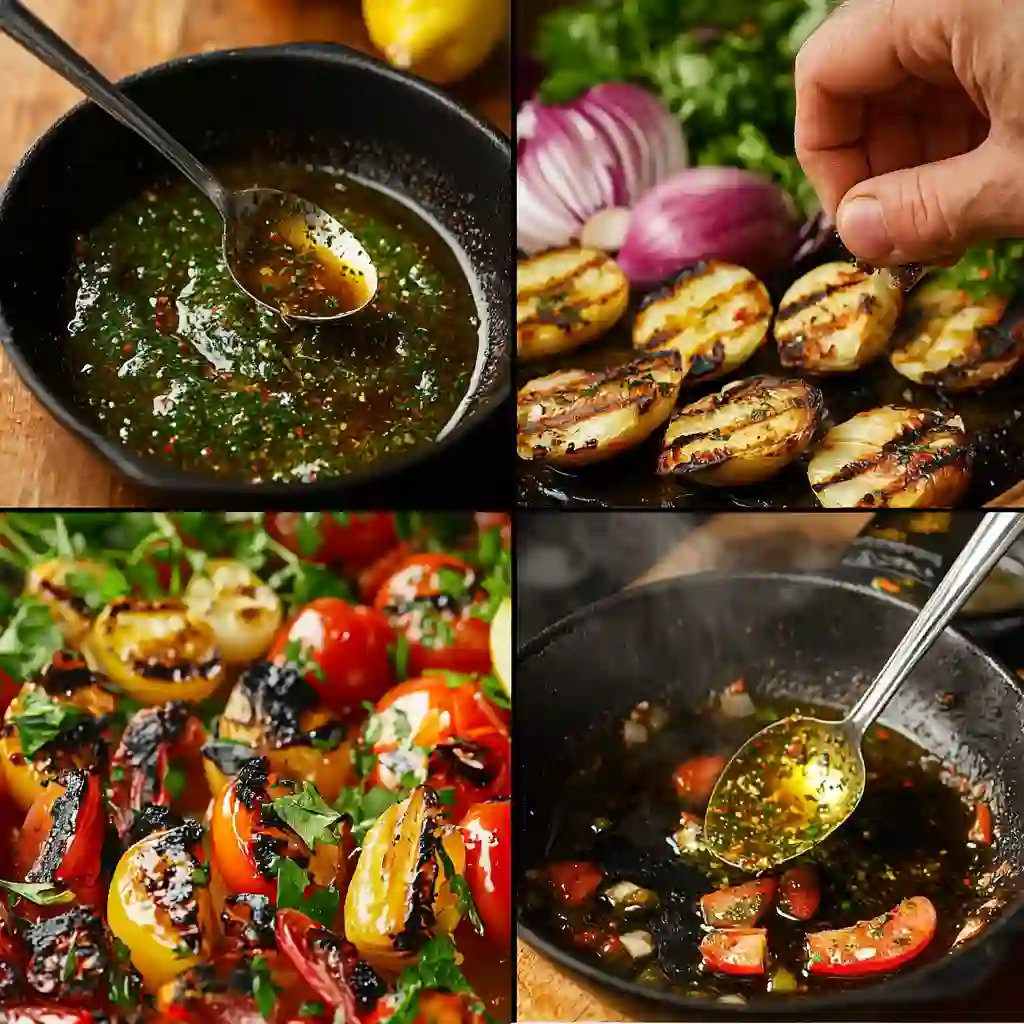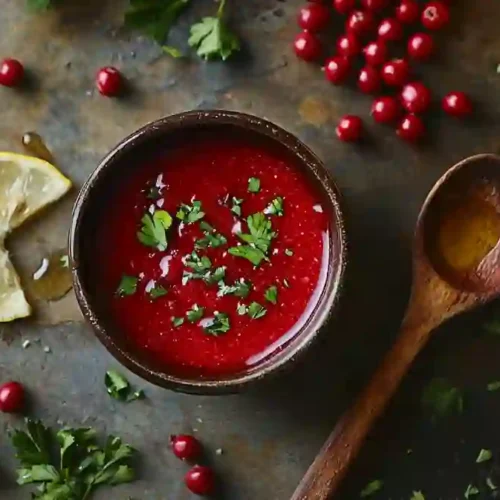
Table of Contents
I fell in love with sumac sauce the first time I drizzled it over roasted vegetables—it brings a vibrant lemony tang and antioxidant boost to every dish with just three pantry staples. Whether you use it as a marinade, dressing, or dip, this simple blend elevates flavors without extra sugar or fat, making it a go-to condiment for quick weeknight meals and special-occasion spreads alike.
What is Sumac Sauce?
Sumac sauce is a tangy and flavorful condiment that highlights the bold taste of sumac spice. This versatile sauce is made by blending sumac powder with other simple ingredients, such as olive oil, garlic, and yogurt, to create a creamy and zesty mixture. Its unique flavor profile, which is both tart and slightly citrusy, makes it a perfect pairing for a wide range of dishes.
Moreover, sumac sauce stands out because of its adaptability. It can be used as a dressing for fresh salads, a marinade for grilled meats, or even a dipping sauce for vegetables. These multiple uses make it an essential addition to any kitchen. Unlike other condiments, sumac sauce delivers a punch of flavor without overpowering the main dish.
Additionally, sumac sauce connects deeply with Middle Eastern and Mediterranean culinary traditions. The key ingredient, sumac spice, has been a part of these cuisines for centuries. According to this guide on culinary spices, sumac’s bright and zesty taste plays a vital role in many traditional recipes.
For more ideas on how to incorporate sumac dip into your meals, explore this collection of easy recipes that celebrate bold flavors.
Health Benefits
Sumac sauce offers not only great flavor but also several health benefits. Sumac spice, the main ingredient, contains antioxidants that fight free radicals in the body. These antioxidants reduce inflammation, which plays a key role in maintaining overall health. Additionally, sumac supports digestion and promotes a healthy gut.
This sauce works well with many diets, such as vegan, gluten-free, and Mediterranean. It delivers flavor without any artificial additives, making it a natural and wholesome choice. For example, spices like sumac enhance both the taste and the nutritional value of meals. A guide on Mediterranean ingredients highlights how they contribute to balanced diets.
Sumac dip also adds variety to meals without extra effort. You can use it in salads, marinades, or as a dip to keep your meals exciting and nutritious.
Key benefits of sumac sauce:
- Rich in antioxidants: Protects cells and reduces damage.
- Anti-inflammatory properties: Lowers inflammation naturally.
- Diet-friendly: Suitable for vegan, gluten-free, and natural diets.
- Supports digestion: Improves gut health for better comfort.
In summary, sumac dip enhances meals with its unique flavor and many health benefits. Its versatility and natural ingredients make it a great choice for anyone looking to enjoy healthy and flavorful food.
How to Make Sumac Sauce
Creating sumac sauce at home is incredibly simple, and it allows you to tailor the flavor to your liking. With just a few basic ingredients and easy steps, you can make a delicious and versatile condiment that pairs well with various dishes. Moreover, making it yourself ensures freshness and control over the ingredients.

Ingredients you’ll need:
- 2 tablespoons of sumac spice
- 1 cup of plain yogurt (or a dairy-free alternative)
- 1 tablespoon of olive oil
- 1 clove of garlic, minced
- Salt to taste
- Optional: a squeeze of lemon juice for extra tanginess
Steps to prepare sumac sauce:
- Combine the yogurt, olive oil, and minced garlic in a bowl.
- Add the sumac spice and mix thoroughly until the ingredients are well blended.
- Season with salt and adjust the flavor by adding lemon juice, if desired.
- Chill the sauce for 15–20 minutes to let the flavors meld together.
- Serve it as a dip, dressing, or topping.
For an even fresher taste, you can grind whole sumac berries into powder using a spice grinder. This approach enhances the sauce’s vibrancy and aroma.
Tips for perfect sumac sauce:
- Use high-quality yogurt to achieve a creamy texture.
- Experiment with variations, such as adding tahini or fresh herbs like parsley.
- Store the sauce in an airtight container for up to three days.
Sumac Sauce in Modern Cuisine
In today’s kitchens, sumac dip has found a new identity as chefs creatively incorporate it into contemporary dishes. Its tangy and slightly citrusy flavor profile makes it a favorite in fusion cuisine, where traditional elements blend with modern culinary techniques. Additionally, the vibrant hue of the sauce adds a visual appeal, enhancing both the taste and presentation of meals.
Modern uses of sumac sauce include:
- Gourmet Toppings: Drizzle it over avocado toast or flatbreads for a zesty finish.
- Fusion Burgers: Use it as a condiment for burgers, pairing its tanginess with rich and savory patties.
- Creative Salads: Combine it with quinoa or kale salads to add depth to the flavors.
- Street Food Inspirations: Pair it with tacos or wraps for a Middle Eastern twist.
- Vegan Delights: Use it in grain bowls or as a dip for falafel to complement plant-based meals.
Furthermore, sumac sauce plays a key role in enhancing the overall dining experience by adding a surprising yet delightful burst of flavor.
In conclusion, sumac dip proves its versatility by seamlessly fitting into both traditional and modern recipes. As you experiment with its uses, you will discover how this simple condiment can elevate your meals to gourmet levels. Whether you’re preparing a casual brunch or a fancy dinner, sumac dip offers endless possibilities for culinary creativity.
Where to Buy Sumac
Finding high-quality sumac spice and sumac sauce is essential to enjoying their rich flavors and health benefits. Fortunately, they are widely available both online and in physical stores, ensuring easy access for everyone. Moreover, knowing where to buy the best products guarantees a fresher and more authentic taste.
Top places to purchase sumac and sumac sauce:
- Specialty Stores: Middle Eastern or Mediterranean grocery stores are excellent sources of fresh sumac products.
- Online Retailers: Websites like Amazon and specialized spice shops offer a variety of sumac powders and pre-made sauces.
- Farmers’ Markets: Local markets sometimes sell handcrafted sumac sauce, perfect for those seeking artisanal quality.
- Supermarkets: Large grocery chains often carry sumac in their international food aisles.
- DIY Options: Buy dried sumac berries to grind your own spice at home for maximum freshness.
FAQs
Sumac sauce often sparks curiosity among those new to Middle Eastern or Mediterranean cuisine. To help you fully appreciate this flavorful condiment, here are answers to some frequently asked questions. Moreover, these tips will ensure you make the most of it in your cooking.
1. What does sumac sauce taste like?
Sumac sauce has a tangy, citrus-like flavor that is both refreshing and zesty. Furthermore, its unique taste comes from sumac spice, which adds a slightly savory and tart note to dishes.
2. Is sumac sauce spicy?
No, sumac sauce is not spicy. Instead, it has a mild, tangy flavor that enhances dishes without overpowering them, making it suitable for various taste preferences.
3. Can I make sumac sauce without tahini or yogurt?
Absolutely! While yogurt or tahini are common ingredients, you can easily create a dairy-free or nut-free version by using olive oil and lemon juice as a base. As a result, the sauce remains tangy and delicious.
4. What is Sumac Dressing Made Of?
Sumac dressing is a tangy and slightly citrusy dressing often used in Middle Eastern cuisine. It typically includes Sumac, Olive oil, Lemon juice, Garlic, Honey or maple syrup, Salt and black pepper.
5. What Is Sumac Sauce Made Of?
Sumac sauce is a tangy and creamy condiment that pairs well with grilled meats, seafood, and vegetables. It features sumac for tartness, yogurt or tahini for a smooth base, and garlic for depth of flavor. Lemon juice enhances acidity, while olive oil adds richness. Seasoned with salt and pepper, its consistency can be adjusted with water if needed.
6. Is sumac sauce vegan and gluten-free?
Most traditional recipes for sumac sauce are naturally vegan and gluten-free. Therefore, it is an excellent option for those with dietary restrictions.
7. What is the flavor of sumac?
Sumac has a tangy, citrus-like flavor with a slight tartness that brightens dishes. Its taste is often compared to lemon but is less acidic, making it a unique and versatile spice for enhancing various recipes.
8. What spice tastes like sumac?
Lemon zest or lemon juice are common substitutes for sumac as they provide a similar tangy and citrusy profile. Additionally, vinegar can mimic its tartness, though it lacks sumac’s distinct earthy undertone.
Conclusion
Sumac sauce is undoubtedly a must-try condiment for anyone looking to elevate their meals. Not only is it incredibly versatile, but it is also packed with flavor and health benefits. Its tangy, citrus-like taste complements a wide variety of dishes, from fresh salads to hearty grilled meats. Additionally, the simplicity of its preparation makes it accessible for both novice and experienced cooks.
Moreover, sumac sauce’s adaptability ensures it can cater to diverse dietary needs, including vegan and gluten-free options. Whether you use it as a dip, dressing, or marinade, this zesty sauce has the potential to transform even the simplest meal into something extraordinary. For those seeking creative ways to incorporate it into their dishes, the possibilities are virtually endless.
In summary, sumac dip is more than just a condiment—it’s a flavorful addition that brings a touch of the Middle East to your kitchen. By trying this sauce, you’re not only expanding your culinary repertoire but also embracing a healthier and tastier way of eating. Don’t wait to experience the unique magic of sumac dip in your own cooking.

Sumac Sauce
Ingredients
- ½ cup sour cream
- ½ cup low-fat yogurt or Greek yogurt
- 1 teaspoon lemon zest
- 1 to 2 tablespoons lemon juice to taste
- 1 small clove garlic finely minced or crushed
- 1 tablespoon extra virgin olive oil
- 1 tablespoon ground sumac
- ½ teaspoon salt adjust to taste
- ¼ teaspoon ground black pepper adjust to taste
Instructions
- Combine Dairy Base: In a mixing bowl, add the sour cream and yogurt. Stir until smooth and well combined.
- Add Flavorings: Incorporate the lemon zest, lemon juice, minced garlic, olive oil, ground sumac, salt, and black pepper into the dairy mixture.
- Mix Thoroughly: Using a whisk or spoon, blend all ingredients until the sauce is smooth and uniform in texture.
- Adjust Seasoning: Taste the sauce and adjust salt, pepper, or lemon juice as needed to achieve the desired flavor balance.
- Serve or Store: The sauce can be served immediately or refrigerated in an airtight container for up to one week. Stir well before each use.
Notes
- Consistency Variations: For a thicker sauce, opt for Greek yogurt. If a thinner consistency is preferred, traditional yogurt or a small amount of buttermilk can be used to adjust the texture.
- Serving Suggestions: This versatile sauce pairs well with salads, grilled meats, roasted vegetables, or as a dip for bread and crudités.
- Storage Tip: Store the sauce in a sealed container in the refrigerator. For optimal freshness, consume within one week.
